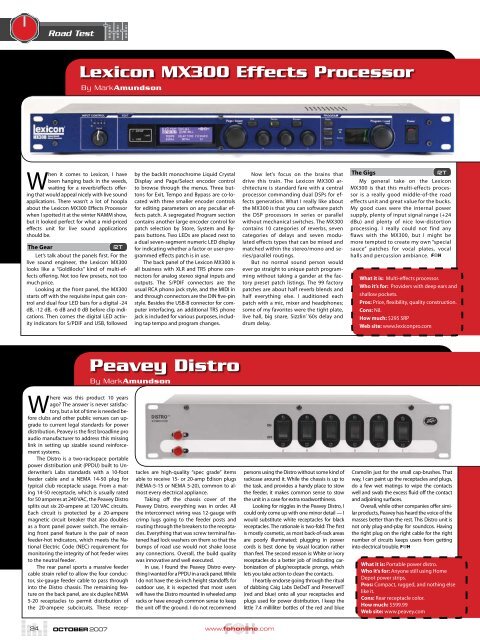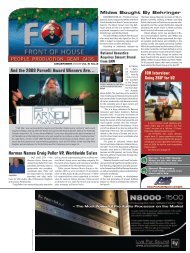Create successful ePaper yourself
Turn your PDF publications into a flip-book with our unique Google optimized e-Paper software.
Where was this product 10 years<br />
ago? The answer is never satisfactory,<br />
but a lot of time is needed before<br />
clubs and other public venues can upgrade<br />
to current legal standards for power<br />
distribution. Peavey is the first broadline pro<br />
audio manufacturer to address this missing<br />
link in setting up sizable sound reinforcement<br />
systems.<br />
The Distro is a two-rackspace portable<br />
power distribution unit (PPDU) built to Underwriter’s<br />
Labs standards with a 10-foot<br />
feeder cable and a NEMA 14-50 plug for<br />
typical club receptacle usage. From a mating<br />
14-50 receptacle, which is usually rated<br />
for 50 amperes at 240 VAC, the Peavey Distro<br />
splits out six 20-ampere at 120 VAC circuits.<br />
Each circuit is protected by a 20-ampere<br />
magnetic circuit breaker that also doubles<br />
as a front panel power switch. The remaining<br />
front panel feature is the pair of neon<br />
feeder-hot indicators, which meets the National<br />
Electric Code (NEC) requirement for<br />
monitoring the integrity of hot feeder wires<br />
to the neutral feeder.<br />
The rear panel sports a massive feeder<br />
cable strain relief to allow the four conductor,<br />
six-gauge feeder cable to pass through<br />
into the Distro chassis. The remaining feature<br />
on the back panel, are six duplex NEMA<br />
5-20 receptacles to permit distribution of<br />
the 20-ampere subcircuits. These recep-<br />
24<br />
Road Test<br />
When it comes to Lexicon, I have<br />
been hanging back in the weeds,<br />
waiting for a reverb/effects offering<br />
that would appeal nicely with live sound<br />
applications. There wasn’t a lot of hoopla<br />
about the Lexicon MX300 Effects Processor<br />
when I spotted it at the winter NAMM show,<br />
but it looked perfect for what a mid-priced<br />
effects unit for live sound applications<br />
should be.<br />
The Gear RT<br />
Let’s talk about the panels first. For the<br />
live sound engineer, the Lexicon MX300<br />
looks like a “Goldilocks” kind of multi-effects<br />
offering. Not too few presets, not too<br />
much price.<br />
Looking at the front panel, the MX300<br />
starts off with the requisite input gain control<br />
and dual four LED bars for a digital -24<br />
dB, -12 dB, -6 dB and 0 dB before clip indications.<br />
Then comes the digital LED activity<br />
indicators for S/PDIF and USB, followed<br />
Lexicon MX300 Effects Processor<br />
OCTOBER 2007<br />
By MarkAmundson<br />
by the backlit monochrome Liquid Crystal<br />
Display and Page/Select encoder control<br />
to browse through the menus. Three buttons<br />
for Exit, Tempo and Bypass are co-located<br />
with three smaller encoder controls<br />
for editing parameters on any peculiar effects<br />
patch. A segregated Program section<br />
contains another large encoder control for<br />
patch selection by Store, System and Bypass<br />
buttons. Two LEDs are placed next to<br />
a dual seven-segment numeric LED display<br />
for indicating whether a factor or user-programmed<br />
effects patch is in use.<br />
The back panel of the Lexicon MX300 is<br />
all business with XLR and TRS phone connectors<br />
for analog stereo signal inputs and<br />
outputs. The S/PDIF connectors are the<br />
usual RCA phono jack style, and the MIDI in<br />
and through connectors are the DIN five-pin<br />
style. Besides the USB-B connector for computer<br />
interfacing, an additional TRS phone<br />
jack is included for various purposes, including<br />
tap tempo and program changes.<br />
Peavey Distro<br />
By MarkAmundson<br />
tacles are high-quality “spec grade” items<br />
able to receive 15- or 20-amp Edison plugs<br />
(NEMA-5-15 or NEMA 5-20), common to almost<br />
every electrical appliance.<br />
Taking off the chassis cover of the<br />
Peavey Distro, everything was in order. All<br />
the interconnect wiring was 12-gauge with<br />
crimp lugs going to the feeder posts and<br />
routing through the breakers to the receptacles.<br />
Everything that was screw terminal fastened<br />
had lock washers on them so that the<br />
bumps of road use would not shake loose<br />
any connections. Overall, the build quality<br />
was innovative and well executed.<br />
In use, I found the Peavey Distro everything<br />
I wanted for a PPDU in a rack panel. While<br />
I do not have the six-inch height standoffs for<br />
outdoor use, it is expected that most users<br />
will have the Distro mounted in wheeled amp<br />
racks or have enough common sense to keep<br />
the unit off the ground. I do not recommend<br />
www.fohonline.com<br />
Now let’s focus on the brains that<br />
drive this train. The Lexicon MX300 architecture<br />
is standard fare with a central<br />
processor commanding dual DSPs for effects<br />
generation. What I really like about<br />
the MX300 is that you can software patch<br />
the DSP processors in series or parallel<br />
without mechanical switches. The MX300<br />
contains 10 categories of reverbs, seven<br />
categories of delays and seven modulated<br />
effects types that can be mixed and<br />
matched within the stereo/mono and series/parallel<br />
routings.<br />
But no normal sound person would<br />
ever go straight to unique patch programming<br />
without taking a gander at the factory<br />
preset patch listings. The 99 factory<br />
patches are about half reverb blends and<br />
half everything else. I auditioned each<br />
patch with a mic, mixer and headphones;<br />
some of my favorites were the tight plate,<br />
live hall, big snare, Sizzlin’ ‘60s delay and<br />
drum delay.<br />
persons using the Distro without some kind of<br />
rackcase around it. While the chassis is up to<br />
the task, and provides a handy place to stow<br />
the feeder, it makes common sense to stow<br />
the unit in a case for extra roadworthiness.<br />
Looking for niggles in the Peavey Distro, I<br />
could only come up with one minor detail — I<br />
would substitute white receptacles for black<br />
receptacles. The rationale is two-fold: The first<br />
is mostly cosmetic, as most back-of-rack areas<br />
are poorly illuminated; plugging in power<br />
cords is best done by visual location rather<br />
than feel. The second reason is: White or ivory<br />
receptacles do a better job of indicating carbonization<br />
of plug/receptacle prongs, which<br />
lets you take action to clean the contacts.<br />
I heartily endorse going through the ritual<br />
of dabbing Caig Labs DeOxIT and PreserveIT<br />
(red and blue) onto all your receptacles and<br />
plugs used for power distribution. I keep the<br />
little 7.4 milliliter bottles of the red and blue<br />
The Gigs RT<br />
My general take on the Lexicon<br />
MX300 is that this multi-effects processor<br />
is a really good middle-of-the road<br />
effects unit and great value for the bucks.<br />
My good cues were the internal power<br />
supply, plenty of input signal range (+24<br />
dBu) and plenty of nice low-distortion<br />
processing. I really could not find any<br />
flaws with the MX300, but I might be<br />
more tempted to create my own “special<br />
sauce” patches for vocal plates, vocal<br />
halls and percussion ambiance.<br />
What it is: Multi-effects processor.<br />
Who it’s for: Providers with deep ears and<br />
shallow pockets.<br />
Pros: Price, flexibility, quality construction.<br />
Cons: Nil.<br />
How much: $295 SRP<br />
Web site: www.lexiconpro.com<br />
Cramolin just for the small cap-brushes. That<br />
way, I can paint up the receptacles and plugs,<br />
do a few wet matings to wipe the contacts<br />
well and swab the excess fluid off the contact<br />
and adjoining surfaces.<br />
Overall, while other companies offer similar<br />
products, Peavey has heard the voice of the<br />
masses better than the rest. This Distro unit is<br />
not only plug-and-play for soundcos. Having<br />
the right plug on the right cable for the right<br />
number of circuits keeps users from getting<br />
into electrical trouble.<br />
What it is: Portable power distro.<br />
Who it’s for: Anyone still using Home<br />
Depot power strips.<br />
Pros: Compact, rugged, and nothing else<br />
like it.<br />
Cons: Rear receptacle color.<br />
How much: $599.99<br />
Web site: www.peavey.com
















